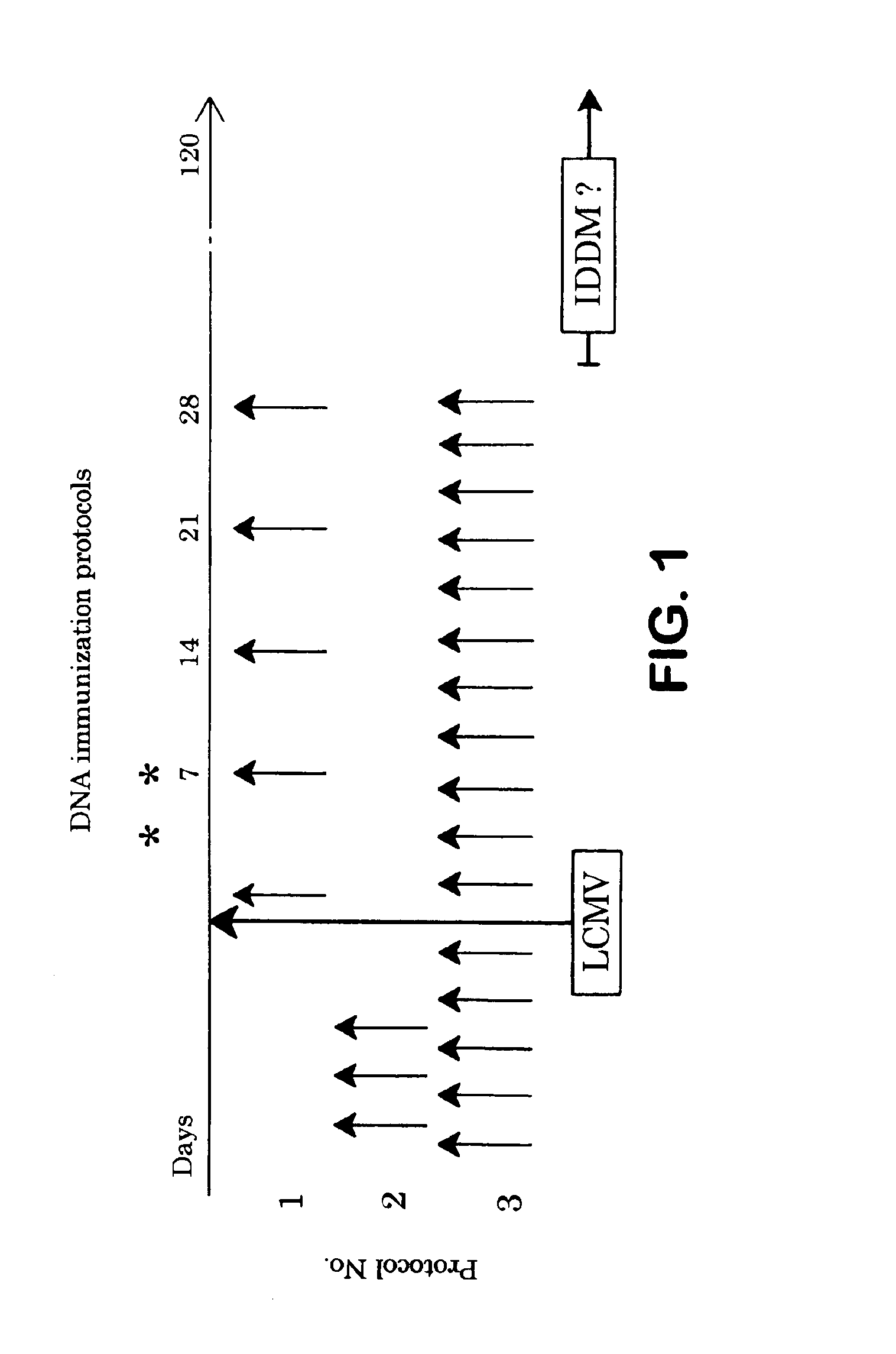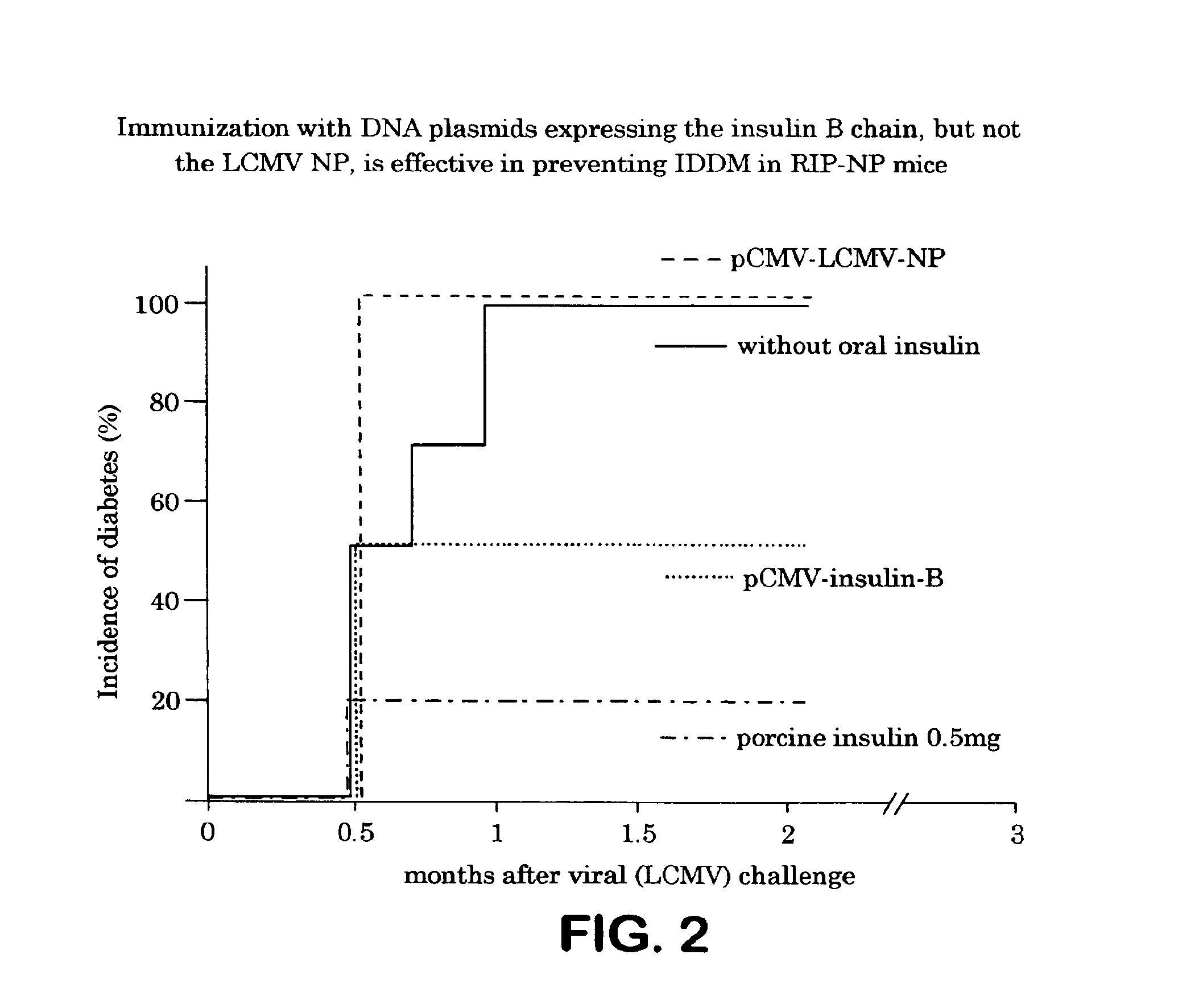Compositions and methods for the treatment or prevention of autoimmune diabetes
- Summary
- Abstract
- Description
- Claims
- Application Information
AI Technical Summary
Benefits of technology
Problems solved by technology
Method used
Image
Examples
example i
Inoculation of Diabetic Transgenic Mice
[0123]In order to demonstrate the advantages of the present invention, inducible diabetic transgenic mice were obtained and vaccinated with the disclosed compositions. More particularly, the transgenic RIP-LCMV NP 25-3 H-2d mouse line used in the following Examples expresses the nucleoprotein (NP) of LCMV under control of the rat insulin promoter (RIP) in the pancreatic β-cells as well as in the thymus, but not in any other tissues. Balb / c non-transgenic H-2d mice were used as controls in some experiments (8). The virus used for induction of IDDM was LCMV Armstrong (ARM) strain (clone 53b). Four to 21 week old RIP-NP 25-3 mice were inoculated intraperitoneally (i.p.) with 1×105 pfu LCMV ARM in a volume of 0.2 ml.
[0124]Selected mice were orally innoculated with porcine insulin purified from pancreatic glands (Novo Nordisk, Bagsvaerd, Denmark) as well as other control peptides. Insulin was solubilized in acid buffer, pH adjusted and the solution ...
example ii
Progression of Diabetes in Immunized and Non-Immunized Mice
[0127]Blood samples from the immunized RIP-LCMV mice from Example I, along with non-immunized controls were screened for diabetes twice a week from 10 weeks of age by testing for hyperglycemia by blood glucose tests. Diabetes was defined by two consecutive blood glucose analyses (Accucheck III analyzer, Boehringer Mannheim, Indianapolis, Ind.) with values above 350 mg / dl. The results of this screening are shown in FIG. 2.
example iii
Transfer of Splenocytes from Insulin-B Protected Mice Prevents IDDM
[0128]DNA-immunized mice were challenged with LCMV, and blood glucose levels were followed for 1 month to identify “protected” and “non-protected” mice. Splenocytes were harvested from “protected” mice (pCMV-ins-B immunized, protocol 1) or from “non-protected” mice (PCMV-NP immunized, protocol 1 or 2), and were cultured in vitro with the antigen stimulus shown above. After 3 days of culture, IL-4 and IFN-γ levels in tissue culture supernatants were determined by ELISA as follows:
[0129]Cytokines (IL-4, IFN-γ) produced by splenocytes were detected using the ELISA (Pharmingen, San Diego, Calif.) assay. Briefly, 96-well Millititer™ HA plates (Millipore, Bedford, Mass.) were coated with the respective capture antibodies for IL-4 and IFN-γ diluted to 2 μg / ml. After overnight incubation at 4° C., plates were washed 4 times with PBS-TWEEN 20 (0.05%) and pre-incubated with PBS containing 10% FCS for 1 hour at RT. Tissue cultu...
PUM
| Property | Measurement | Unit |
|---|---|---|
| Fraction | aaaaa | aaaaa |
| Fraction | aaaaa | aaaaa |
| Fraction | aaaaa | aaaaa |
Abstract
Description
Claims
Application Information
 Login to View More
Login to View More - R&D
- Intellectual Property
- Life Sciences
- Materials
- Tech Scout
- Unparalleled Data Quality
- Higher Quality Content
- 60% Fewer Hallucinations
Browse by: Latest US Patents, China's latest patents, Technical Efficacy Thesaurus, Application Domain, Technology Topic, Popular Technical Reports.
© 2025 PatSnap. All rights reserved.Legal|Privacy policy|Modern Slavery Act Transparency Statement|Sitemap|About US| Contact US: help@patsnap.com



